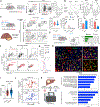Tumor-derived erythropoietin acts as an immunosuppressive switch in cancer immunity
- PMID: 40273234
- PMCID: PMC12110762
- DOI: 10.1126/science.adr3026
Tumor-derived erythropoietin acts as an immunosuppressive switch in cancer immunity
Abstract
Successful cancer immunotherapy requires a patient to mount an effective immune response against tumors; however, many cancers evade the body's immune system. To investigate the basis for treatment failure, we examined spontaneous mouse models of hepatocellular carcinoma (HCC) with either an inflamed T cell-rich or a noninflamed T cell-deprived tumor microenvironment (TME). Our studies reveal that erythropoietin (EPO) secreted by tumor cells determines tumor immunotype. Tumor-derived EPO autonomously generates a noninflamed TME by interacting with its cognate receptor EPOR on tumor-associated macrophages (TAMs). EPO signaling prompts TAMs to become immunoregulatory through NRF2-mediated heme depletion. Removing either tumor-derived EPO or EPOR on TAMs leads to an inflamed TME and tumor regression independent of genotype, owing to augmented antitumor T cell immunity. Thus, the EPO/EPOR axis functions as an immunosuppressive switch for antitumor immunity.
Conflict of interest statement
Figures






References
-
- Galon J et al., Type, density, and location of immune cells within human colorectal tumors predict clinical outcome. Science 313, 1960–1964 (2006). - PubMed
-
- Galon J, Bruni D, Approaches to treat immune hot, altered and cold tumours with combination immunotherapies. Nat Rev Drug Discov 18, 197–218 (2019). - PubMed
MeSH terms
Substances
Grants and funding
LinkOut - more resources
Full Text Sources
Medical
Molecular Biology Databases
Research Materials

